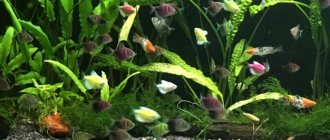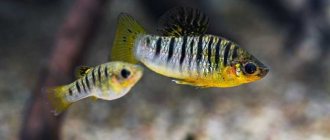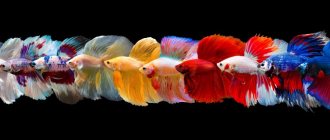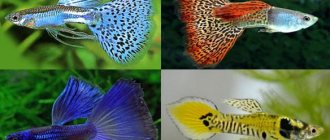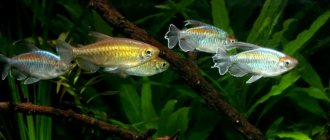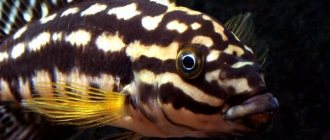Ternetia is one of the most popular aquarium fish, easily recognizable by its characteristic fan-shaped shape. Unpretentious, easy to get along with most fish, breeds well in captivity - it is perfect for beginners.
| Full name | lat. Gymnocorymbus ternetzi |
| Kinds | Ternetia vulgare. There are also several artificial breeds - veil, albino, caramel thorn and glofish. |
| Color | Silver with black stripes. The breeds come in all sorts of colors, with the most popular being blue, yellow, green, red, pink and purple. |
| Water | pH – 6.0-7.5 KH (hardness) – less than 20 From 22℃ to 26℃ (for some breeds a couple of degrees higher) |
| Feed | They prefer any live food (daphnia, cyclops, bloodworms), but protein-rich dry foods can also be used. |
| Compatibility | With many peace-loving fish, such as characins or poecilliids. |
| Lifespan | Up to 6 years |
Description with photo
In the wild, the common thorn can be found in the waters of South America . The main habitats are Brazil and Bolivia . The fish belongs to the Kharacin family and has an inconspicuous dark gray color.
As a decorative addition, her body, shaped like a rounded diamond, has three wide black stripes.
Beautiful anal fin in the form of a large oval. When kept in an aquarium, it can reach a length of 6–7 cm .
How to determine sex and the main differences between a female and a male
Determining the sex of Glofish is quite difficult, since males and females do not have pronounced color differences.
Males on the left, female on the right.
However, the aquarist can always pay attention to the following signs:
- females are always larger and wider than males;
- “girls” are distinguished by a wide anal fin;
- in “boys” the dorsal fin is very pointed.
As a rule, the sexual differences between males and females in Ternetia become clearly visible when the fish reaches the age of 7-8 months.
Popular varieties
Breeders, as usual, were not satisfied with the inconspicuous appearance of the thorn. Thanks to their efforts, aquarists have received wonderful varieties that are significantly superior in decorativeness to their wild parents.
They changed not only the color of the hybrids, but also the shape of the fins.
Today you can buy veil, yellow, and white thornets, but aquarium lovers are most interested in two types: caramel and glofish.
Caramel
To obtain bright caramel shades, special dyes are introduced into the fish’s body, which is why, as can be seen in the photo, thorns acquire unexpected colors from lemon to blue and emerald green.
However, such intervention gives a short-term effect: the bright color quickly fades, and the fish loses its charm.
Glofish
If you compare glofish with caramel, it seems that they are exactly the same species. However, it is not. How to distinguish thorny glofish from caramel?
The fact is that the glo color acquired by introducing an additional gene from the jellyfish Aequorea victoria or the coral Discosoma does not disappear. Plus, they glow when lit at night.
Approximately how much do they cost?
The price of fish varies greatly. The cheapest are ordinary thornets, which can be bought for even 50 rubles (although usually more expensive). Caramels and glofishes are much more expensive - more than a hundred rubles, and the price of some glofishes (for example, can exceed 400).
As you can see, ternetia, due to its unpretentiousness and ability to live with many types of fish, is perfect for beginners. The variety of colors of glowfish allows you to choose a fish of any desired color. Finally, they are easy to breed in captivity, which will allow you to maintain the population and even create your own hybrids.
The only advice is that it is still better to refrain from buying caramels - these fish are essentially sick and crippled due to such operations, and glowfish will be a good replacement for them.
Maintenance and care
Despite its hybrid origin, Ternetia Glo is not much different in content from its wild relatives. It makes the same demands on water, plants and temperature .
Aquarium parameters
Since the glofish is a schooling fish, it needs a large aquarium . There should be at least 10 liters of water per individual.
If you plan to keep a flock of 8-10 fish, take an aquarium with a volume of at least 120 liters. In such a “house” they will have a place to swim and a place to hide in the thick of plants.
Be sure to equip the aquarium with a lid : frisky little ones can jump out of it, carried away by the game.
General requirements
In terms of water parameters, you should stick to average values. Replace it once a week, draining 25% of the volume . The temperature is kept within 20...25 °C. For glo, it is desirable that the water is always warm enough.
Plants
Dense vegetation in an aquarium with thorns is welcome, but it is planted along the walls, leaving free front space for swimming flocks.
Plants are selected with narrow and long leaves (hydrotrich, elodea, cabomba). Between them the flattened body of the fish will pass unhindered.
Attention! For greater decorativeness, Java moss is planted on the ground.
Priming
Soil does not play a big role in the life of glos; they prefer to swim in the middle and upper layers of water . However, many fish owners cover the bottom with dark types of soil, which perfectly highlight the bright colors of the thorns.
Several small shelters will not interfere with pets. You can use small pebbles or sand as soil .
View this post on Instagram
Posted by Ancistrus and Ternetia 300 L (@ancistrus2020) Jun 9, 2020 at 3:20 PDT
Equipment
The aquarium is equipped with a filter and aerator . The first can be both internal and external. The main thing is that they do not cause a strong current in the reservoir.
A heater is only needed if it is difficult to maintain the temperature in the house around 22...25 °C.
Lighting
Daylight hours last 10–12 hours. An aquarium lamp should work for the same amount of time. Choose a lamp for it without thermal effect and low power.
Attention! Do not keep the aquarium in direct sunlight: the fish will not like it, and the water may bloom.
Water
The parameters of the water containing thornets look like this:
- acidity - 6–8 pH;
- hardness - 10–19 dH;
- temperature not lower than 20 °C.
Adviсe
- For dark thirds, choose a light background. And bright GloFish look impressive against a dark plain background.
- Place the aquarium away from sunlight to prevent algal blooms.
- Do not turn on the aquarium lights suddenly. First, turn on the light in the room, let the fish get used to the light, after which you can turn on the aquarium lamp.
- The exact water temperature in the aquarium can be determined using an immersion thermometer. A sticker thermometer gives results with errors.
We invite you to familiarize yourself with the vision of cats as they see
Ternetia is an interesting aquarium fish that changes color depending on its mood. When frightened, the fish's body turns dirty silver.
Previous
FishTOP 9 types of labyrinth fish
Next
Fish14 popular viviparous aquarium fish
- Don't neglect adapting newly purchased fish to new water. You cannot place the fish from the shipping bag directly into the aquarium. Pour water from the aquarium gradually in small portions every 10-15 minutes.
- Place new inhabitants in the community aquarium at night when the rest of the fish are sleeping.
- To clean the aquarium, use a siphon with transparent elements, this will greatly simplify cleaning.
- Avoid metal scrapers for aquarium glass. Such devices scratch the walls of the tank.
- Do not buy dry food by weight, look at the date of manufacture.
- To reduce the pressure of the filter, install it on a wide wall of the aquarium.
- Caramels look interesting against a dark or plain background.
In European countries, there are movements promoting refusal to buy artificially colored fish, as many consider it inhumane. The healthiest alternative to caramel is GloFish, a genetically modified fish that inherits bright colors.
Feeding
The natural food of fish is insect larvae and small insects themselves . This means that they prefer foods rich in protein.
When feeding dry food, choose types in the form of flakes and chips : they remain on the surface of the water for a long time.
They will not be able to pick up live food that has fallen to the bottom due to the specific structure of their oral cavity.
Important! Caramel and glofish need to be added to the diet with food with color enhancers.
Diet
Our charges are not too capricious in everything, including the menu. They welcome not only live and dry food, but also their analogues. Freshly frozen food in the form of bloodworms, brine shrimp, and daphnia is a good option for replacing classic, dry food. Rest assured: any particle of food that falls to the bottom will be eaten very quickly. But first of all, thorns eat up everything that floats in the middle layers of water.
Finely chopped spinach stems or zucchini fruits are an excellent treat for fish that will help strengthen their immunity.
Diseases and prevention
By their nature, thorns are little susceptible to disease, they have good immunity and high endurance.
With proper care, they rarely get sick, but it is difficult to completely avoid pet health problems.
Abnormalities in the body can be seen by the appearance of the fish:
- restless behavior;
- swallowing air from the surface of the water;
- clouding of color;
- the appearance of specks on the fins;
- secretion of mucus on the gills.
Among the diseases we should highlight:
- Acidosis . Occurs when the acidity of water is low. It manifests itself in restless behavior, frequent jumping out of the water, and the appearance of mucus. The fish must be transplanted into a separate container with a water temperature of 30 °C and salt added.
- Acedemia . The cause of the disease is oversaturation of water with ammonia. The first sign is darkening of the color. To prevent illness, you should keep the aquarium perfectly clean and change the water on time.
- The appearance of black dots on the pet’s body is associated with a fungal infection of the fish. Treatment begins by placing the diseased individual in a separate container and adding a fungicide (Parachlorphenoxytol) to the water.
Do you want thorns to hurt rarely? Keep them in a species aquarium, carefully treat the soil and plants.
Nutrition
Breeding of thorns is easy, since the fish adapt well to their environment and are unpretentious in food. The phenotype is happy to feast on both protein and plant foods, while the diet should be balanced and contain mineral supplements and vitamins. Proper nutrition and the availability of live food: daphnia, crustaceans, bloodworms and artemia will help take care of the health of your pets and maintain the brightness of their color. After feeding, any remaining food is removed from the pond.
An important fact: due to the structure of the jaw, fish cannot lift food from the bottom.
Nuances of breeding
All types of thornets spawn in a community aquarium . If your plans include breeding at home, then you will have to make a spawning tank for them.
30–40 liters of water is enough for one couple. The bottom is covered with a fine mesh, under which the eggs will fall. If this is not done, the parents will eat their offspring.
The water parameters in the spawning tank must correspond to those inherent in the general aquarium. To stimulate spawning, the water is heated by 2–3 degrees (26…28 °C). It will be ideal for glo thorns.
Sex differences
Female glos are larger than males and have a rounded abdomen. They differ in the shape and size of the fins: the female has a more magnificent anal fin, and the male has a sharper dorsal fin . It is possible to accurately determine the sex of a fish only after 7 months of life.
Spawning
Preparation for spawning begins with intensive feeding of the fish in a common aquarium for 2–3 weeks. Then a pair is selected and placed in a prepared spawning tank .
It should contain plants with small leaves and a fine mesh at the bottom. The lighting is dimmed by covering the front wall with paper or cloth.
As a rule, spawning begins early in the morning, so try to keep an eye on your pets. Immediately after the female lays all the eggs and the male fertilizes them, the parents are removed.
When do glo larvae hatch?
24 hours after the eggs are laid, the larvae hatch. They are very small, their body is transparent, it is difficult to notice the larvae. They attach themselves to the leaves of plants and hang there for about a day.
Then they detach and begin to swim, searching for food. To feed the fry, live dust from ciliates or rotifers is used .
As babies grow, crushed egg yolk (hard-boiled) and Artemia nauplii are introduced into the diet.
Features of reproduction at home
When breeding at home, you can make pairs of equally colored pets or choose multi-colored parents with a pronounced color . Color is inherited.
However, among the offspring, fry may appear with a completely different color, different from the parents, and even without colors at all, ordinary gray-silver.
Setting up a spawning tank
The spawning tank is prepared in advance; a container with a volume of at least 20 liters is suitable for its arrangement. The water should be soft and warm. The temperature is within +24... 28 degrees Celsius, and the hardness is 5-10 units. Melt, rain or boiled water is used to soften the water, and a heater is used to increase the temperature. To prevent the fish from becoming stressed when transplanted into a new environment, some of the water can be taken from the aquarium. The tank must be equipped with an aeration system, but additional light is not needed.
Ternetias reproduce well in natural daylight. The aquarium is located in a quiet place, away from bright sunlight.
To protect the eggs, the bottom is covered with Java moss. Its dense thickets will protect future offspring from hungry parents. But this does not guarantee 100% safety of the eggs. Therefore, for more reliable protection , a separator mesh is installed; it is placed just above the bottom, about 2 cm. The eggs will slip into the cells and, thus, will become inaccessible to adult individuals. For greater stability of the structure, you can put a couple of large stones under the mesh.
Compatibility
Glow fish are naturally friendly and get along well with similarly peaceful species (guppies, gourami).
However, they should not be kept with small and veiled fish , which they will terrorize and constantly pinch. Large predators are also not suitable for them as neighbors - in this case, the thorns themselves will suffer.
With glo barbs
Glo barbs were bred by breeders from Sumatran barbs. Their character is cocky, they are sharp and love to attack.
Keeping glofish with thorns is possible only if the latter form a larger flock.
How to choose the right one when buying, what to look for?
Ternetias are very active fish that should behave agilely and playfully. It is worth paying special attention to the color of the body: it should have a uniform color without spots or light areas. A lethargic, slow and pale fish is unlikely to live long in your aquarium.
Regardless of the condition of new pets, they need to be kept in a quarantine aquarium for a couple of weeks, and only then released into the general aquarium. Healthy Caramels, with proper care, will delight the owner for a long time with their playful character and attractive appearance.
Should I choose the first fish?
Experts believe that peaceful glo ternations are quite suitable for the first experience of keeping fish in an aquarium . They do not require special conditions, suffer little illness, are medium in size and look beautiful in the water.
If all the necessary parameters are met, these fish will delight you with their bright appearance for 3–4 years .
If you like the glofish thorns, feel free to add them to your aquarium. Your pond will be decorated with a bright multi-colored flock that loves to frolic.
The fish reproduce well, and you can enjoy these colorful underwater inhabitants for a long time.
Appearance
The color scheme of the body is gray, flat and slightly stretched in height. Two fuzzy stripes of a darker color run along the entire body. The older the fish, the lighter its color. Eyes set on the sides, a slightly protruding lower jaw, a large fin on the back and a wide anal fin similar to a skirt are its distinctive features. The ability to change color is a unique feature of these fish. In this way, she reacts to stress and changes in the conditions of keeping the ternation.
The size of the aquarium fish Ternetia is small - maximum 6 cm. On average, the fish lives about 3-4 years, with proper care it can live up to 6 years.
See how these beauties behave in the aquarium.
History of creation
GloFish is a patented commercial name for genetically modified aquarium fish. All rights belong to Spectrum Brands, Inc, which purchased them from the creator company Yorktown Technologies in 2021.
And if in our country all this means absolutely nothing and you can easily buy them at any pet store or market, then in the USA everything is much more serious.
The picture is the same in many European countries, where the import of genetically modified organisms is prohibited by law.
True, fish still penetrate into these countries from other countries, and are sometimes sold freely in pet stores.
The name itself consists of two English words - glow (glow, shine) and fish (fish). The history of the appearance of these fish is a little unusual, since scientists initially developed them for completely different tasks.
In 1999, Dr. Zhiyuan Gong and his colleagues at the National University of Singapore worked on the gene for green fluorescent protein, which they extracted from a jellyfish.
The goal of the study was to produce fish that would change color if toxins accumulated in the water.
They introduced this gene into the zebrafish embryo and the resulting fry began to glow with fluorescent light both under ultraviolet and normal light.
After research and obtaining stable results, the university patented its discovery and scientists began further development. They introduced a sea coral gene and orange-yellow fish were born.
Editorial: Guppy
Later, a similar experiment was conducted at National Taiwan University, but the model organism was medaka or rice fish. This fish is also kept in aquariums, but it is much less popular than zebrafish.
Subsequently, the rights to the technology were bought by Yorktown Technologies (headquartered in Austin, Texas) and the new fish received the commercial name - GloFish. At the same time, scientists from Taiwan sold the rights to their invention to the largest aquarium fish breeding company in Asia - Taikong .
Thus, the genetically modified medaka was named TK-1. In 2003, Taiwan became the first country in the world to sell genetically modified pets.
It is reported that one hundred thousand fish were sold in the first month alone. However, genetically modified medaka cannot be called glofish due to the fact that it belongs to a different commercial brand.
However, in the countries of the former USSR it is much less common.
Despite the expectations of the aquarium community (hybrids and new lines very often turn out to be sterile), all glofish are successfully bred in the aquarium and, moreover, pass on their color to their descendants without loss.
The gene donors for the new fish were jellyfish, corals and other marine organisms, including: Aequorea victoria, Renilla reniformis, Discosoma, Entacmaea quadricolor, Montipora efflorescens, Pectinidae, Anemonia sulcata, Lobophyllia hemprichii, Dendronephthya.
Glofish cichlids
Over time, the black-striped cichlid and angelfish were also modified into glofish. They were delayed in hatching them due to the labor-intensive process of their reproduction and the very small number of eggs.
Cichlid GloFish
The angelfish glowed pink, and the cichlid glowed green and pink. The appearance of the angelfish is distinguished by its triangular body and long, ribbon-like fins.
Angelfish GloFish
The cichlid is distinguished by a rounded tail, an oval, harmonious body and a protruding forehead.
